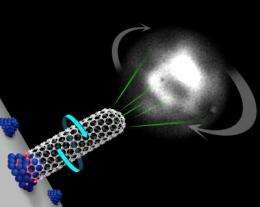Video shows nanotube spins as it grows (w/ Videos)

(PhysOrg.com) -- New video showing the atom-by-atom growth of carbon nanotubes reveals they rotate as they grow, much like the halting motion of a mechanical clock's second hand. Published online this month by researchers at France's Université Lyon1/CNRS and Houston's Rice University, the research provides the first experimental evidence of how individual carbon atoms are added to growing nanotubes.
"The key issue for realizing the potential of carbon nanotubes has always been better control of their growth," said team lead Stephen Purcell of the Université Lyon1/CNRS. "Our findings offer new insights for better measurement, modeling and control of nanotube growth."
Carbon nanotubes are long, hollow cylinders of pure carbon. They are hair-like in shape but are about 100,000 times smaller than human hair. They are also about six times stronger than steel, conduct electricity as well as copper and are almost impervious to radiation and chemical destruction. As a result, scientists are keen to use them in superstrong, "smart" materials, but they need to better understand how to produce them.
"The images from Dr. Purcell's lab show the atom-by-atom 'self assembly' of a nanotube," said Rice co-author Boris Yakobson, professor in mechanical engineering and materials science and of chemistry. "The video offers compelling evidence of the rotational motion that accompanies nanotube growth. It brings to mind Galileo's famous quote, 'And yet, it does turn.'"
In February, Yakobson offered a new theory suggesting that nanotubes grow like tiny, woven tapestries, with new atoms attaching to twisting atomic threads. The new video appears to support the theory, indicating that atoms are added in pairs as the tube spins and grows.
To create the images, Purcell's team at LPMCN (Laboratoire de Physique de la Matičre Condensée et Nanostructures) used a field emission microscope (FEM). A few atoms of metal catalyst were placed on the tip of the FEM's needle-like probe, and carbon nanotubes grew atop the metal catalyst. An electric current was passed lengthwise through the probe and nanotube, and it projected a bright, top-down image of the nanotube onto a phosphor screen. The bright spot was filmed by a video camera, which revealed the nanotube's rotation during growth.
In one case, a nanotube turned approximately 180 times during its 11-minute growth. A frame-by-frame analysis of the video showed that the rotation proceeded in discrete steps -- much like the halting motion of the second hand on a mechanical clock -- with about 24 steps per rotation.
"The results support our predictions of how nanotubes grow," Yakobson said. "The video shows rotational movement during growth, as carbon atoms are added in pairs to the twisting, chiral network of carbon atoms that comprise the nanotube."
Provided by Rice University (news : web)

















